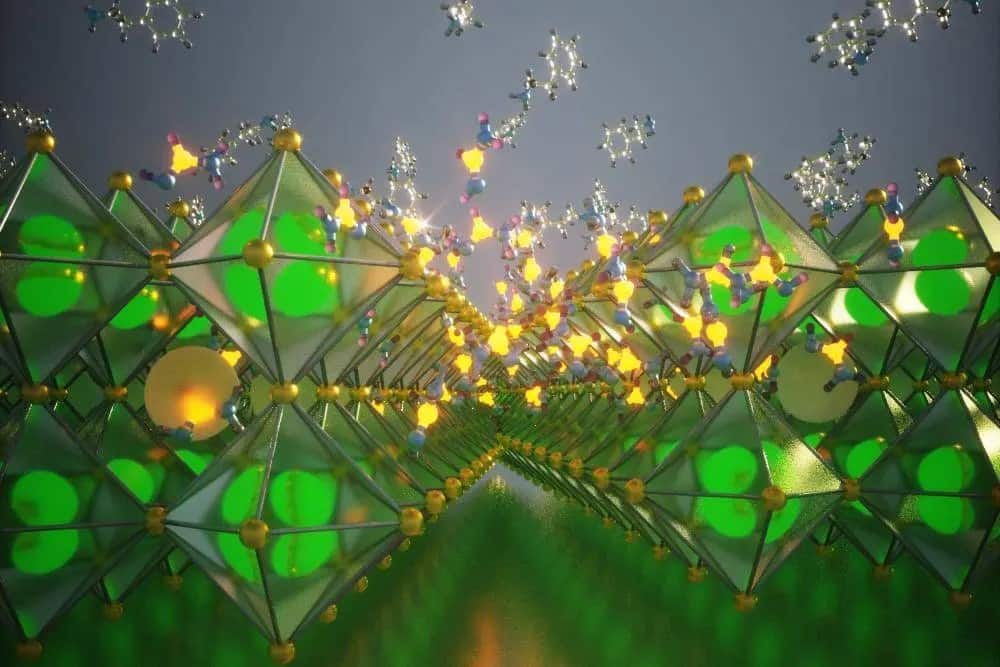
[Image above] An illustration of metal halide perovskites. Engineers led by Georgia Institute of Technology showed that both water and oxygen are required for perovskites to degrade; taking away one of those factors preserved the perovskites’ structure. Credit: Juan-Pablo Correa-Baena, Georgia Institute of Technology
Last year was a big one for perovskite solar cells. Numerous studies reported advancements in both perovskite–silicon tandem cells and all-perovskite cells, as detailed in a July 2023 CTT. Plus, Oxford University spinoff company Oxford PV entered 2024 aiming to finally achieve commercial launch of their tandem solar cell, which they originally planned to launch in 2023.
Despite these advancements, achieving long-term operational stability of perovskite solar technology remains a challenge for researchers.
It is well documented that perovskites, a class of materials with the same crystal structure as calcium titanate, degrade quickly in sunny and humid environments. This sensitivity to real-world conditions would seem to disqualify perovskites as a good material for solar applications.
However, perovskites have high light absorption efficiency and are easily fabricated, which makes them a desirable alternative to silicon, the main material used in today’s solar cells. So, a lot of research has focused on improving the durability of perovskites, such as by combining them in tandem with silicon.
In a recent open-access paper, researchers led by Georgia Institute of Technology made a surprising discovery about the mechanism that causes degradation of perovskites, which could help break down the door to developing all-perovskite solar cells with long-term operational stability.
Their study involved mixed ion perovskites, which are known to provide improved stability compared to their single-cation counterparts. However, these perovskites still “degrade” when exposed to ambient air, i.e., the perovskite structure transforms into nonperovskite phases.
Even though this degradation is well documented, “we lack a clear understanding of the mechanisms that lead to phase instabilities,” the researchers write. So, they used X-ray scattering and spectroscopy, along with density functional theory calculations, to provide a deeper understanding of the chemical interactions that occur between perovskites and the environment.
Their investigation led to an unexpected observation. While exposing perovskites to both water and oxygen led to instability, taking away one of those factors preserved the perovskites’ energy-capturing crystal structure.
“Before this paper, people thought if you expose them to just water, these materials degrade. If you expose them to just oxygen, these materials degrade,” says senior author Juan-Pablo Correa-Baena, assistant professor and Goizueta Early Career Faculty Chair in the School of Materials Science and Engineering at Georgia Tech, in a press release.
But “We’ve decoupled one from the other,” he says. “If you prevent one or the other from interacting with the perovskites, you mostly prevent the degradation.”

The researchers demonstrated the validity of this statement by coating a cesium-and-formamidinium-based halide perovskite film with a hydrophobic layer of phenethylammonium iodide (PEAI). The PEAI molecules’ ability to repel water was enough to stabilize the perovskites’ structure and thus their power conversion efficiency.
However, PEAI does not have good thermal stability, so once sunlight hit the perovskite cells, efficiency dropped. The researchers are working to develop new molecules that can prevent water interactions and remain stable at high temperatures.
The open-access paper, published in Journal of the American Chemical Society, is “Synergistic role of water and oxygen leads to degradation in formamidinium-based halide perovskites” (DOI: 10.1021/jacs.3c05657).
